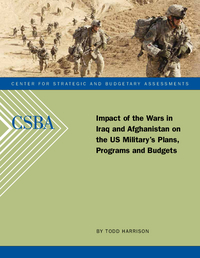
The conflicts in Iraq and Afghanistan have taken a toll on the US military over the past seven years. The strain is being felt throughout the Services, in terms of wear and tear on the troops, their families, and their equipment. Now the United States faces the daunting challenge of resetting the force while continuing to fight two wars and preparing for future adversaries — all in an era of unprecedented economic and budgetary uncertainty. This report addresses the impact of the wars in Iraq and Afghanistan on the plans, programs, and budgets of the US military, specifically those of the US Army, since it has carried much of the burden of fighting these wars.
The wars have had a negative impact on both Army recruiting and retention. While each of the Services has managed to meet recruiting goals each year, the Army has been forced to reduce standards for enlistees and to draw on the Delayed Entry Pool of candidates already in the pipeline. As a result, the quality of Army recruits has diminished significantly — as measured by scores on the Armed Forces Qualifying Test, the percentage of enlistees with high school diplomas, and the number of moral character waivers granted. On the positive side, many key indicators are roughly similar to those of the 1980s, which yielded the Army that performed well in the conflicts of the 1990s. Retention has also suffered, due in large part to the stress created by long and repeated deployments. Efforts to improve retention, particularly the sharp increase in non-cash benefits, much of which was enacted before 2001, have been costly and not well targeted. However, the use of targeted cash bonuses for enlistment and reenlistment does appear to be effective.
The past seven years of conflict have also led to decisions to alter the size and shape of the Army. The force is growing by 65,000 soldiers, and the Army is being reorganized into a more modular force structure centered on Brigade Combat Teams (BCTs). The new BCT force structure will have fewer maneuver battalions and companies than before, with the promise that the addition of Armored Reconnaissance Squadrons and Reconnaissance Surveillance and Target Acquisition Squadrons will serve as combat multipliers to offset this reduction — a proposition that is being tested now in BCT deployments to Iraq and Afghanistan. Although specialized units would be more efficient and effective at conducting irregular warfare operations, and at training and advising indigenous forces, the Army has opted not to develop them, instead focusing on fielding BCTs with “full-spectrum” capabilities.
The impact of the wars on the Army’s modernization plans has not been what one would expect. The Future Combat Systems (FCS) was the Army’s main modernization program, with a price tag projected at upwards of $160 billion. The program’s high cost limited projected fielding of FCS systems to only one third of the active force, with the rest receiving less-capable upgrades to existing equipment.
The FCS also suffered from technical risk; many of the technologies essential to its performance are far from mature. Furthermore, the program appeared greatly weighted toward addressing traditional, or conventional, threats in what has become an era of persistent irregular conflict. Recognizing these problems, Secretary of Defense Robert Gates recently terminated the program’s eight ground combat vehicles. It remains to be seen whether a restructured program will represent an improvement.
Overall materiel readiness has also been affected by the wars. The cost of “resetting” the force — overhauling the existing inventory of equipment, which has seen much higher usage rates in Iraq and Afghanistan — is significant but appears to be sufficiently funded. However, the increased maintenance and repair requirements along with the deteriorating condition of equipment and previously existing shortages combine to worsen the materiel readiness situation further.
Taken together, the impact of the wars on troop quality, force structure, modernization plans, and materiel readiness poses a serious challenge for overall Army readiness. Eroding troop quality, a force structure that is not optimized for irregular warfare, and weapons that are too expensive to field in sufficient quantity risk having devastating consequences on overall military effectiveness.
While the challenge may be daunting, it also presents a unique opportunity for the Army to remake itself into a fighting force better suited for the challenges ahead.



























